This Empanada Gallega Recipe Is Worth The Effort!
Empanada gallega (Galician empanada) is a savory pie from the Spanish region of Galicia with a crispy, flaky dough and a delicious, simple filling.
Usually eaten hot (but sometimes cold), it’s the perfect meal for any time of day – breakfast, brunch, lunch, or dinner, served as an appetizer, or as a tapa.
It is truly everywhere in Galicia because there’s always room for empanada!
This dish has quite a few steps, but it’s well worth the effort. It’s perfect for a big party, family gathering, picnic, or potluck.
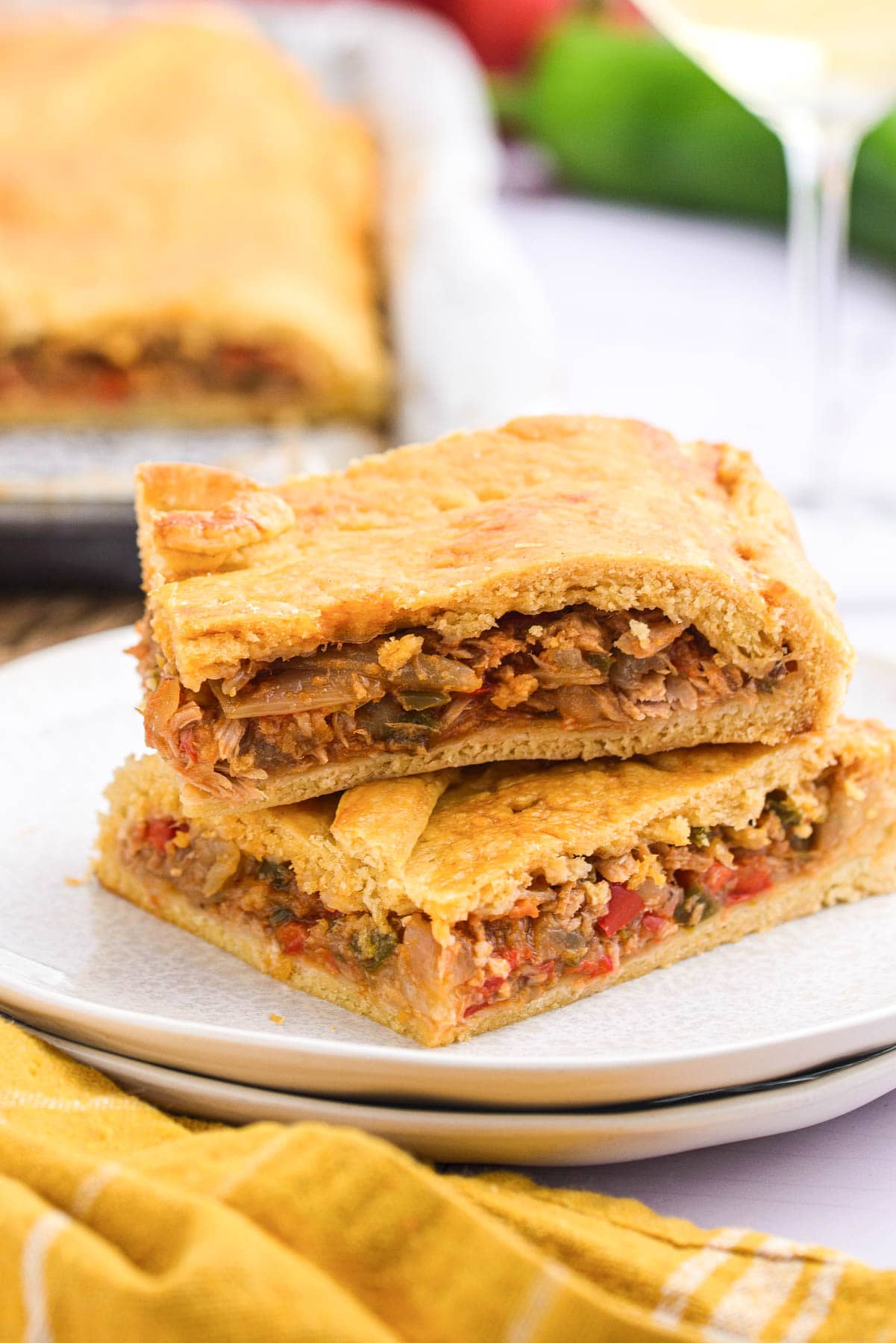
Every town and city in Galicia has its version of Empanada Gallega. They differ mainly in the fillings, but there are also some differences in the way the dough is made.
The most common filling is tuna, peppers, and onions, but you can also make it with cod, octopus, sardines, chicken, or pork.
In this recipe, I’m going to show you the most classic and well-known filling, which is super easy to make and has very easy-to-get ingredients.
Ingredients
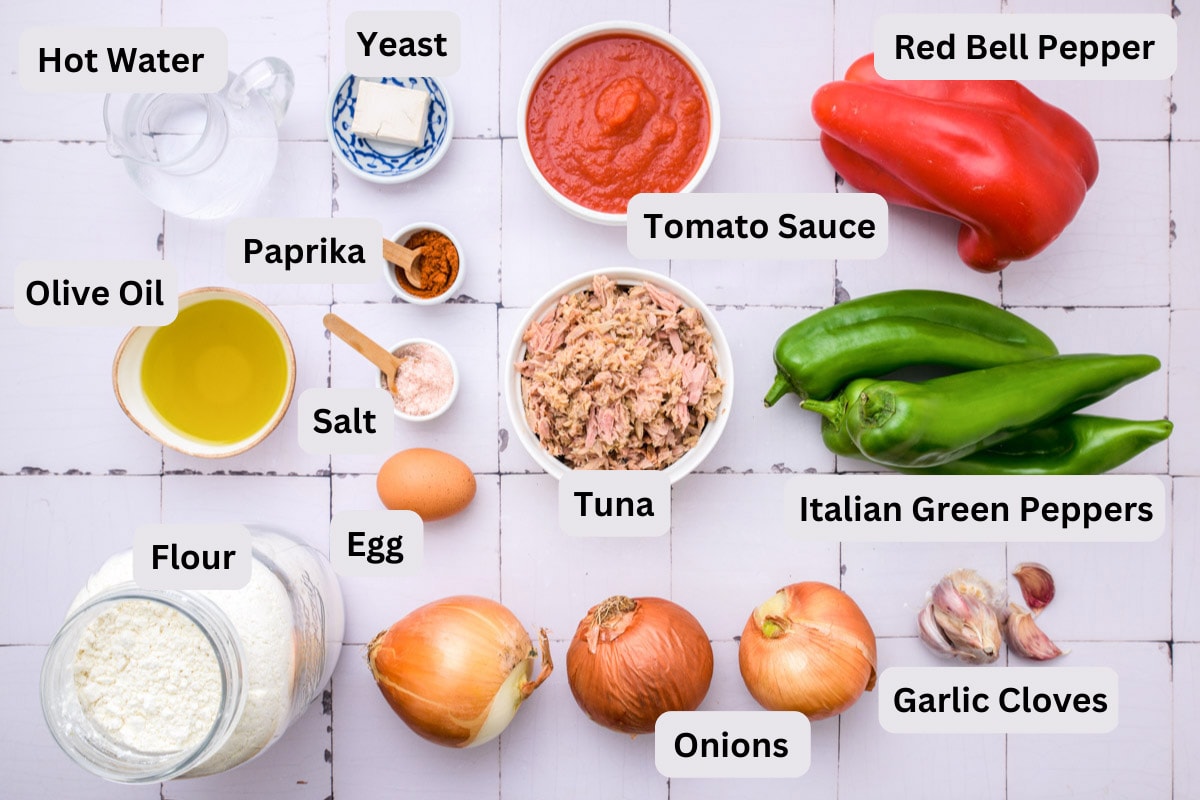
If you want to make this savory Galician pie recipe at home, here are the ingredients that you will need:
- Flour – Regular all-purpose flour. Don’t use self-raising flour.
- Yeast – Either fresh yeast or instant dry yeast. Don’t use active dry yeast.
- Water – Warm water to make the dough.
- Olive oil – Use good quality olive oil, preferably extra-virgin olive oil.
- Salt – To add flavor to the dish.
- Egg – For the egg wash.
- Yellow onions – For the filling. Alternatively, use red onions.
- Italian green peppers – Also known as cubanelle peppers. Alternatively, use green bell peppers. For the filling.
- Red bell pepper – For the filling.
- Garlic cloves – For the filling.
- Tomato sauce – Either homemade and seasoned with olive oil, salt, pepper and a pinch of sugar (if needed) or store-bought. For the filling.
- Canned tuna – Use a good quality plain tuna with no added flavorings. For the filling.
- Sweet paprika – To add flavor to the filling.
Recipe Tips and Substitutions
Before you tackle this empanada gallega recipe, be sure to read through these recipe tips and substitutions so that you have the best chance at success!
- Olive oil: As in any Spanish recipe, good quality olive oil, extra virgin if possible, is a must. Don’t skimp on it when cooking the filling, since you will be using it in the dough. Also, the additional oil can be flavored with thyme, rosemary, or garlic.
- Yeast: Be sure to use yeast that hasn’t expired. You can use instant dry yeast if you can’t find fresh yeast. Don’t use active dry yeast because it would need to be activated first.
- Tuna: Empanada gallega is usually made with bonito tuna, but if you can’t find it, any good quality plain tuna will work.
- Cooking the filling: Sauté the vegetables with enough olive oil to ensure that it gets flavored since we will add it to the dough later. It’s normal for the veggies to soak up a bit of the oil. That’s why it’s a good idea to have extra oil on hand.
- Order: It’s better to make the filling first since we’ll need the flavored oil for the dough. If you are in a rush, you can skip this and simply use raw olive oil for the dough. Another option is to prepare the filling the day before and make the dough and empanada the next day.
- Dough: In the beginning, the dough may feel a bit hard and flaky, but trust the process and keep kneading. Eventually, you’ll be able to form a ball, and once it’s rested and risen, it’s much softer to knead. The proofing time depends on your kitchen temperature.
- Holes: Be sure to make a few holes in the top layer of the empanada to allow steam to escape. Otherwise, you risk your empanada breaking on the sides.
- Texture: The dough should be thin and a little flaky and crispy once cooked. The filling should be juicy, slightly sweet (caramelized), and aromatic.
- Different fillings: Other classic empanada fillings are beef, onion, and chorizo; cod, onion, and raisins; onions and sardines, among others.
How to Make Empanada Gallega – Step by Step Instructions
In this section, you’ll see how to make empanada gallega. We’ve included the recipe process photos so that you can see exactly what each step should look like.
This way, you can compare your progress as you cook!
Of course, the detailed recipe card with all the ingredients and instructions (but no photos) is at the bottom of this post.
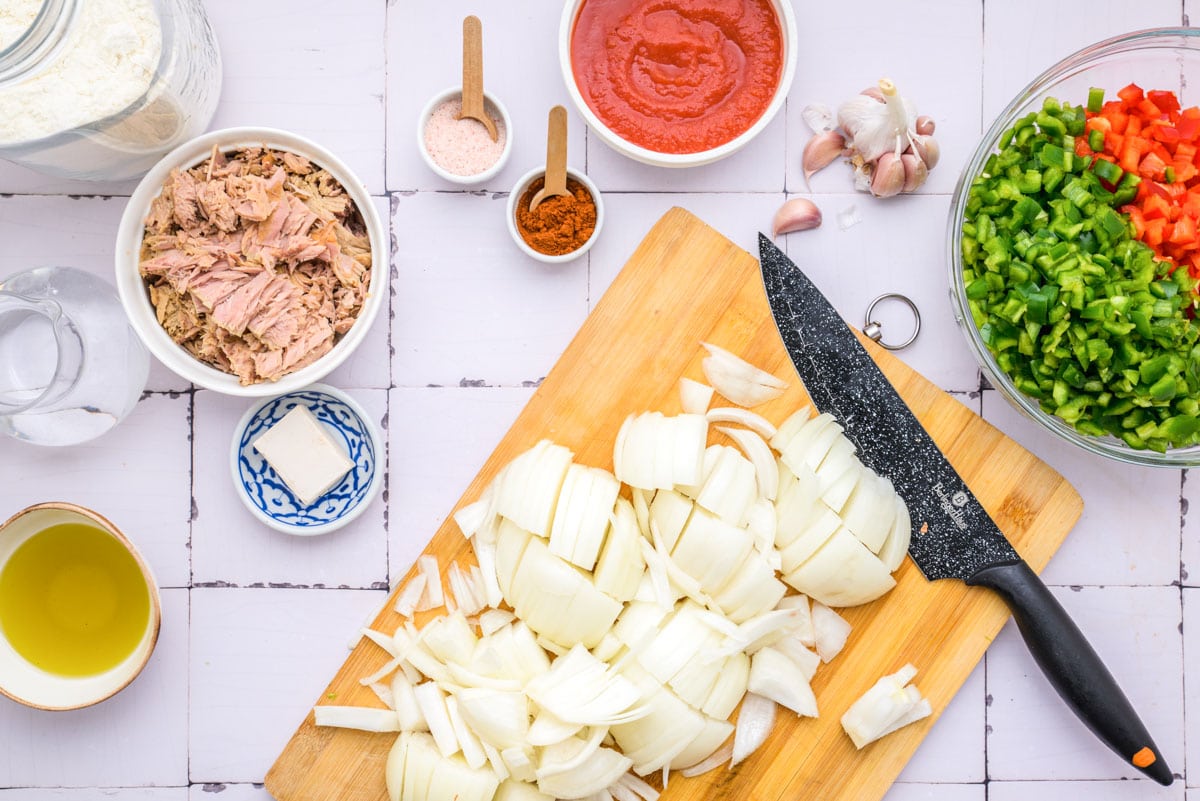
Start by prepping the vegetables. Peel and thinly slice the onions.
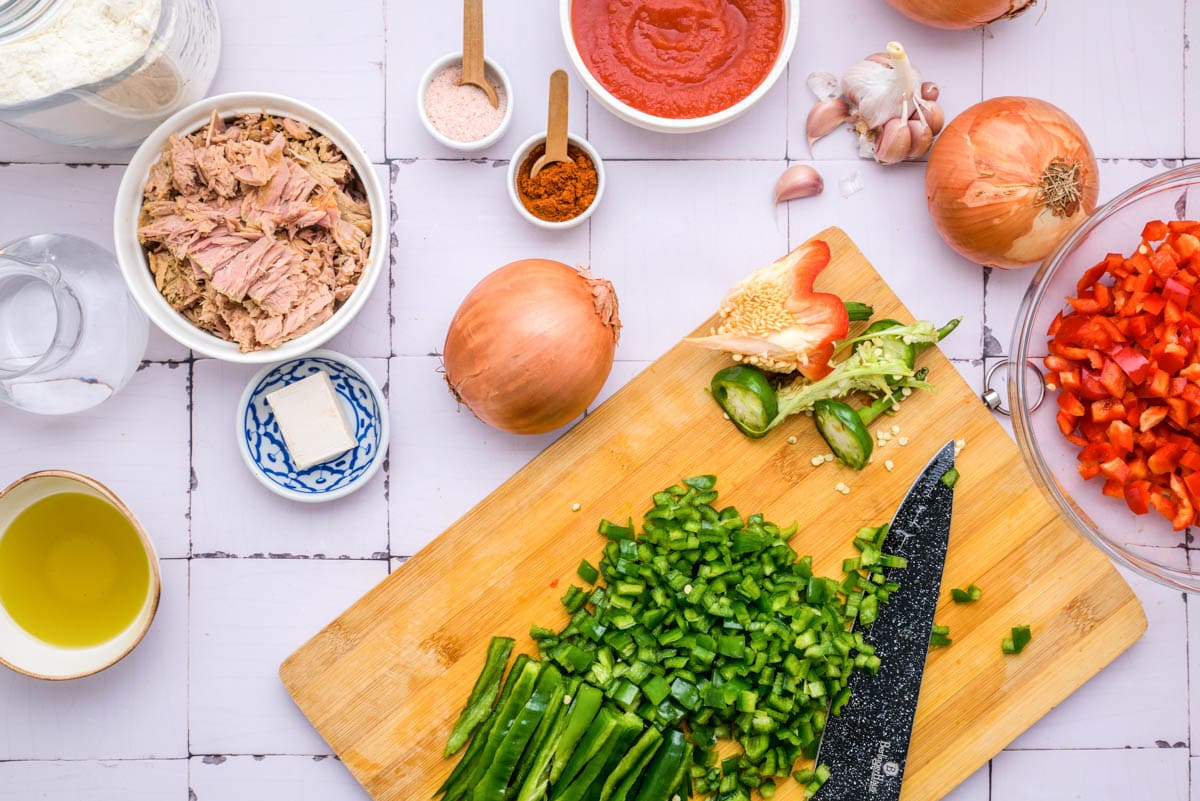
Wash and dry the peppers. Cut them in half and remove the stem and seeds. Dice thinly.
Also, peel and mince the garlic cloves.
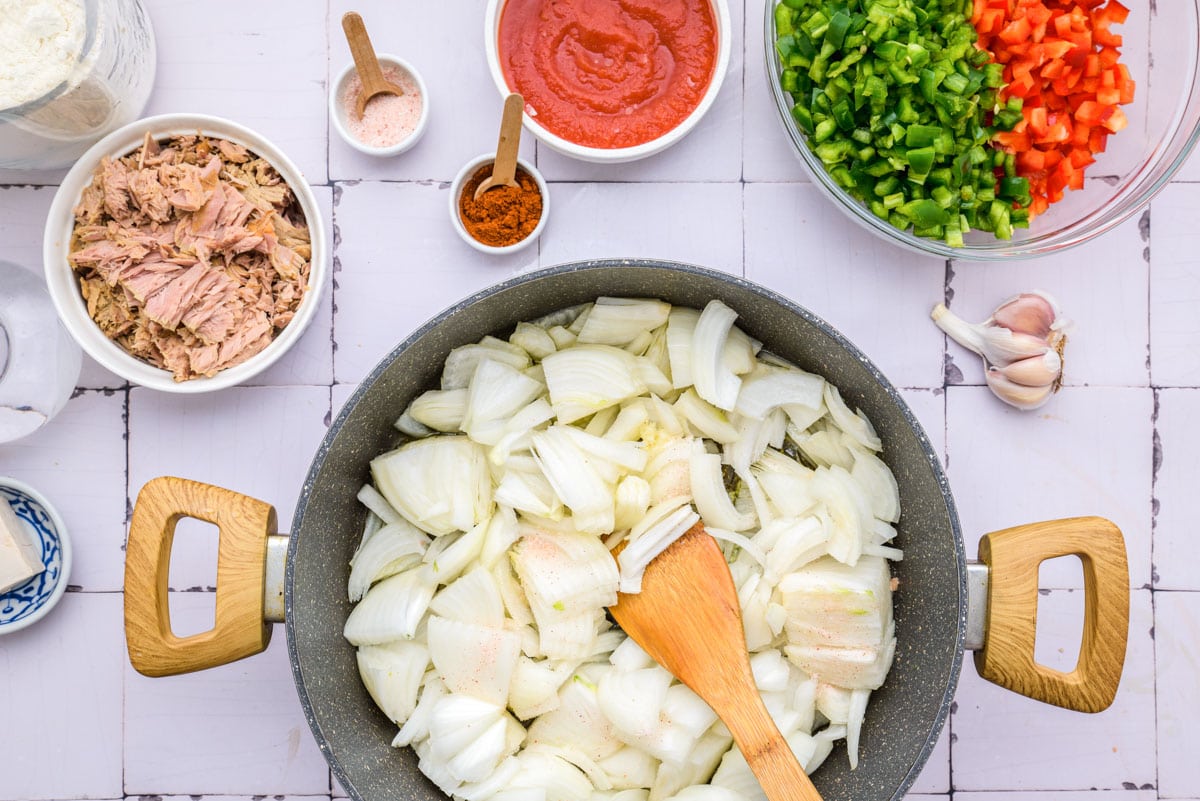
Heat the olive oil in a large pan. When hot, add the veggies, salt, and paprika powder.
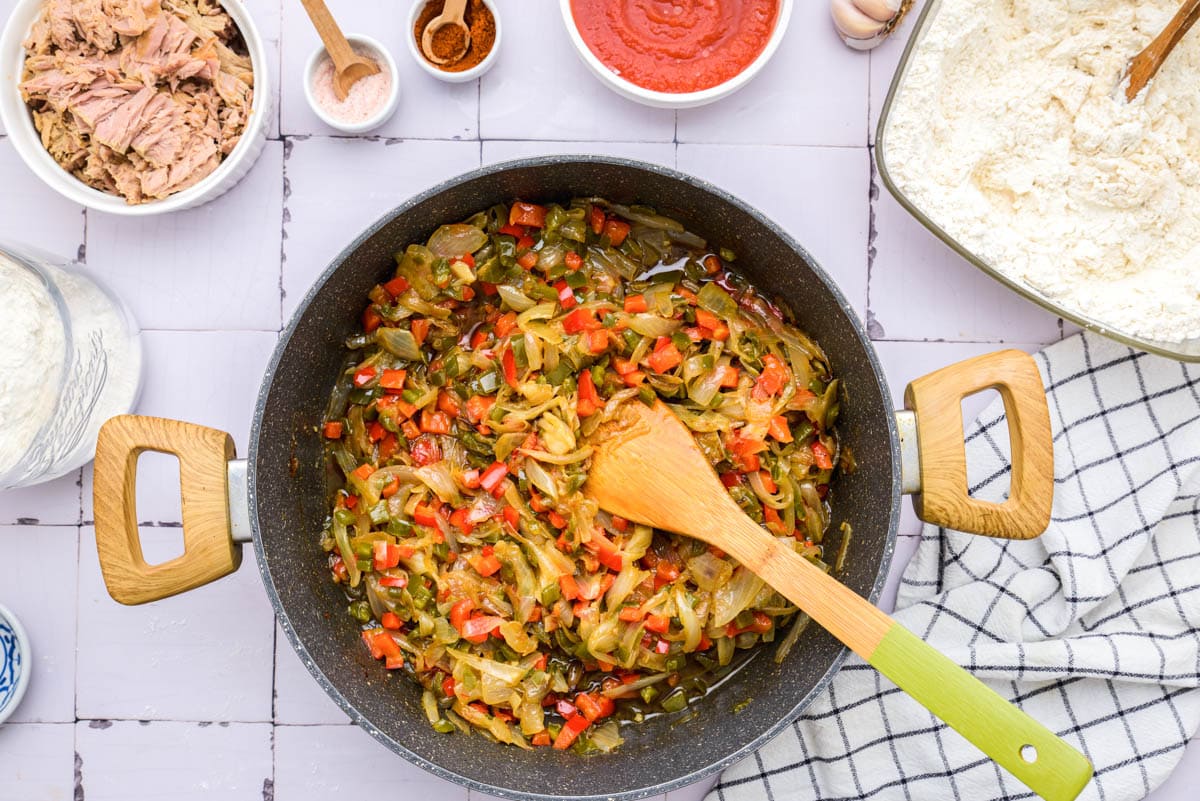
Cook the onions and peppers over medium-low heat until they are golden, soft, and fragrant. The longer the better. Stir regularly.
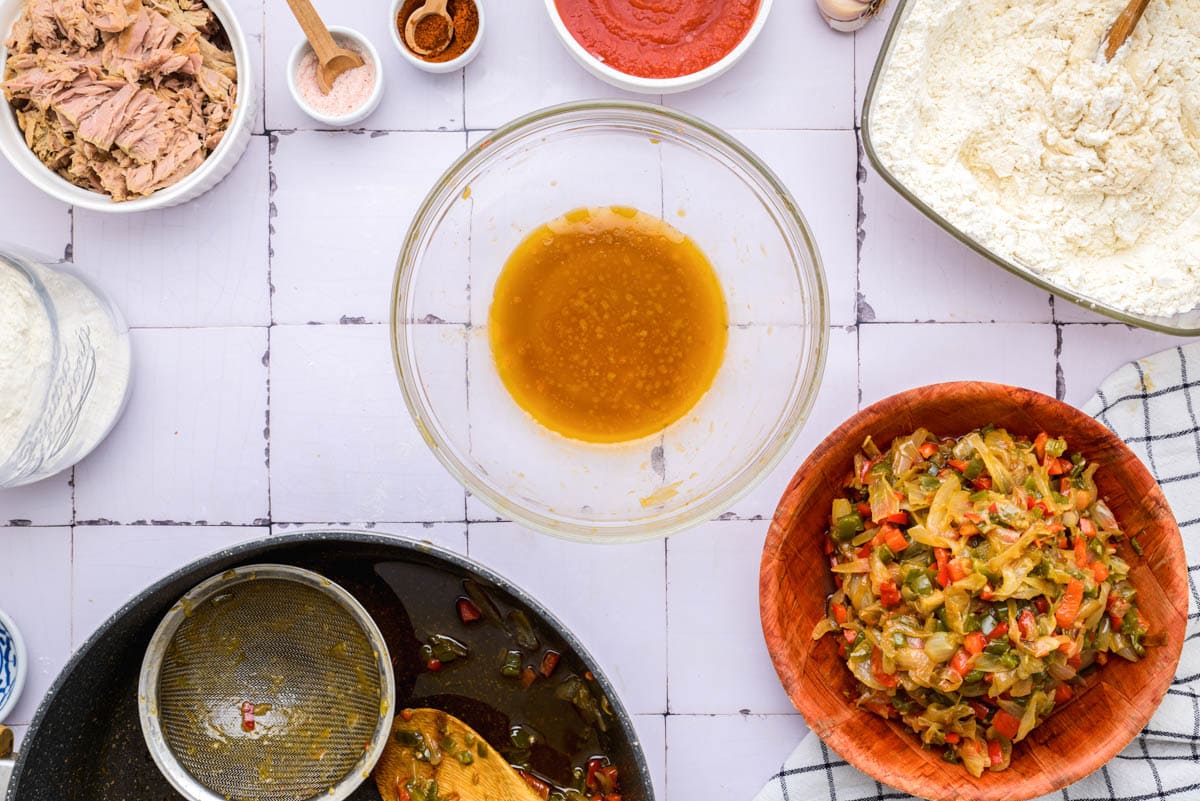
Drain the oil using a fine mesh strainer and a bowl. Set the oil aside.
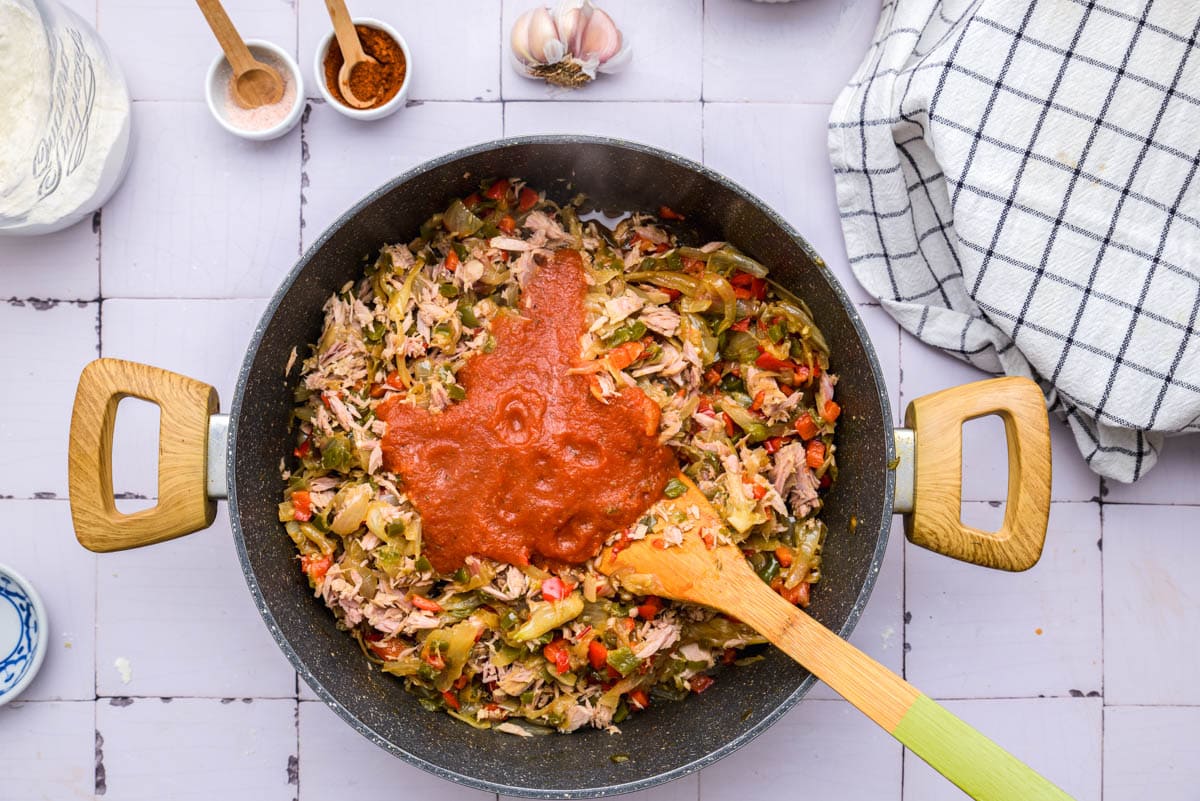
Add the tuna and tomato sauce to the filling and mix well. Set aside.
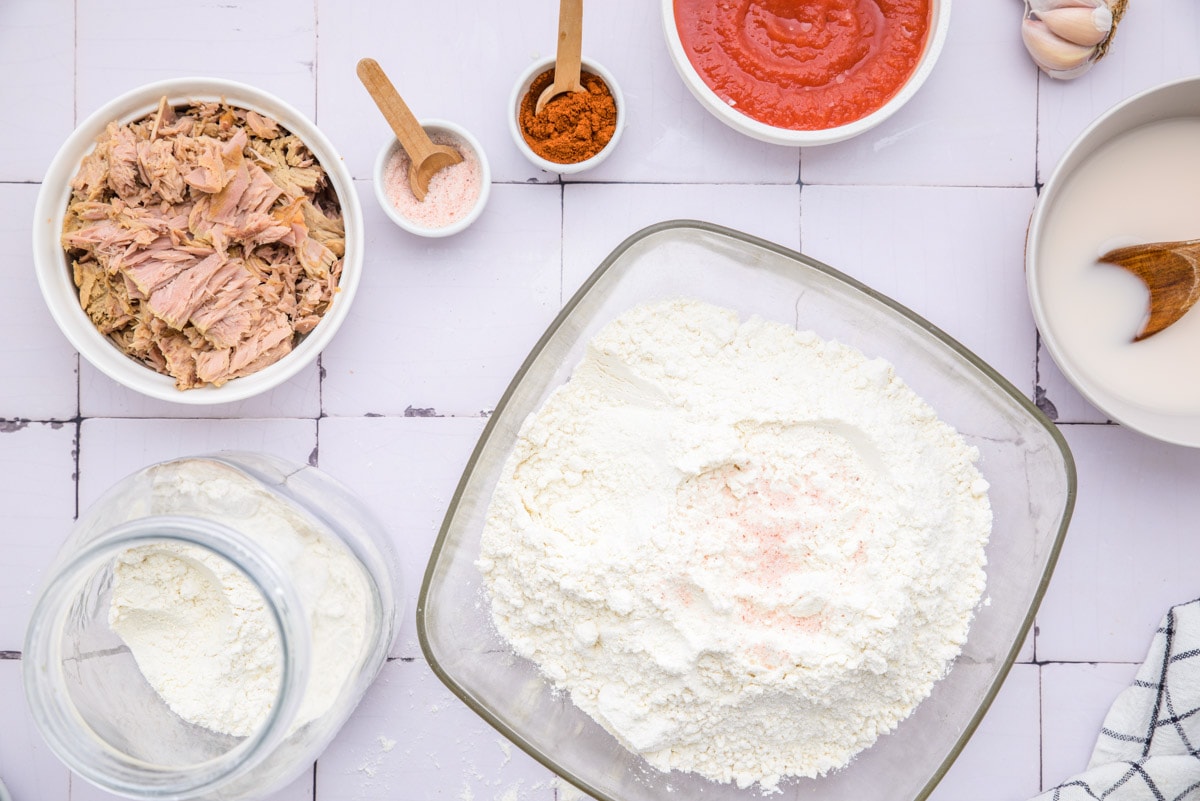
Next, make the dough. In a big bowl, combine flour and salt and mix well.
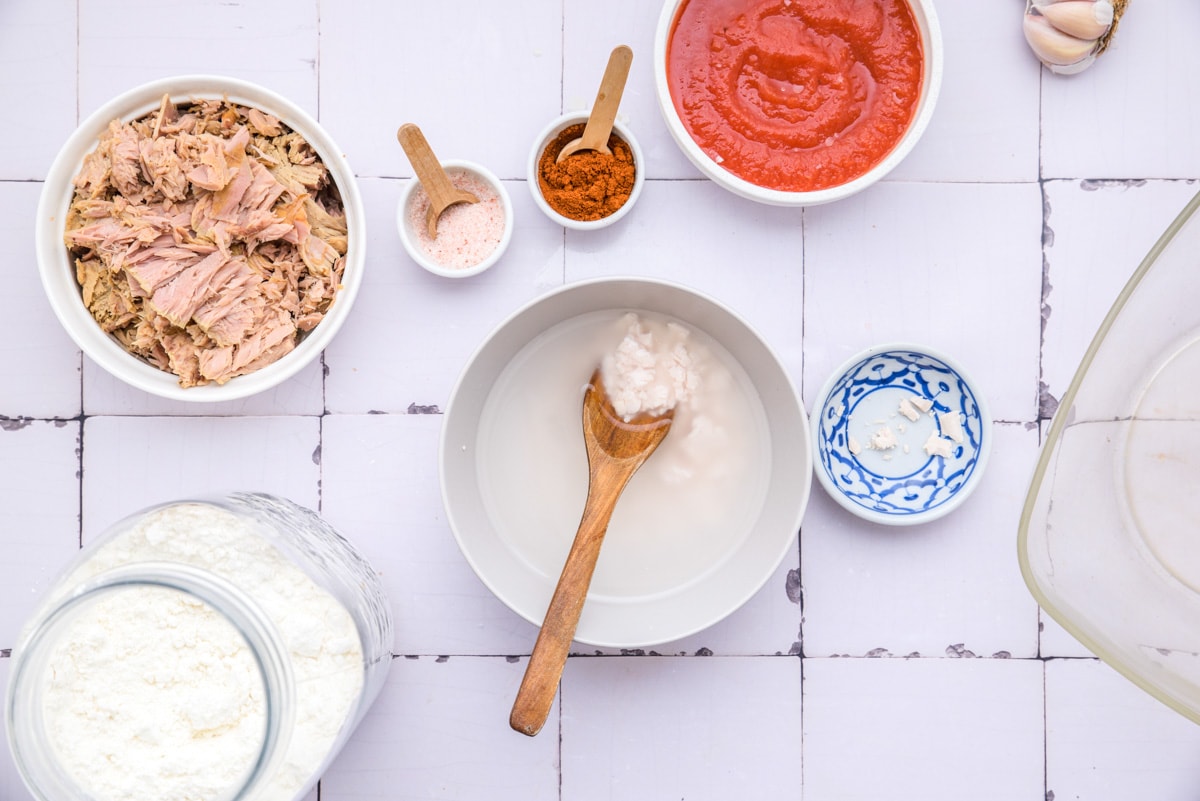
Dissolve the fresh yeast in a small bowl of warm (not boiling) water.
If you’re using instant dry yeast, you don’t need to dissolve it first – just add the water and the yeast to the large bowl.
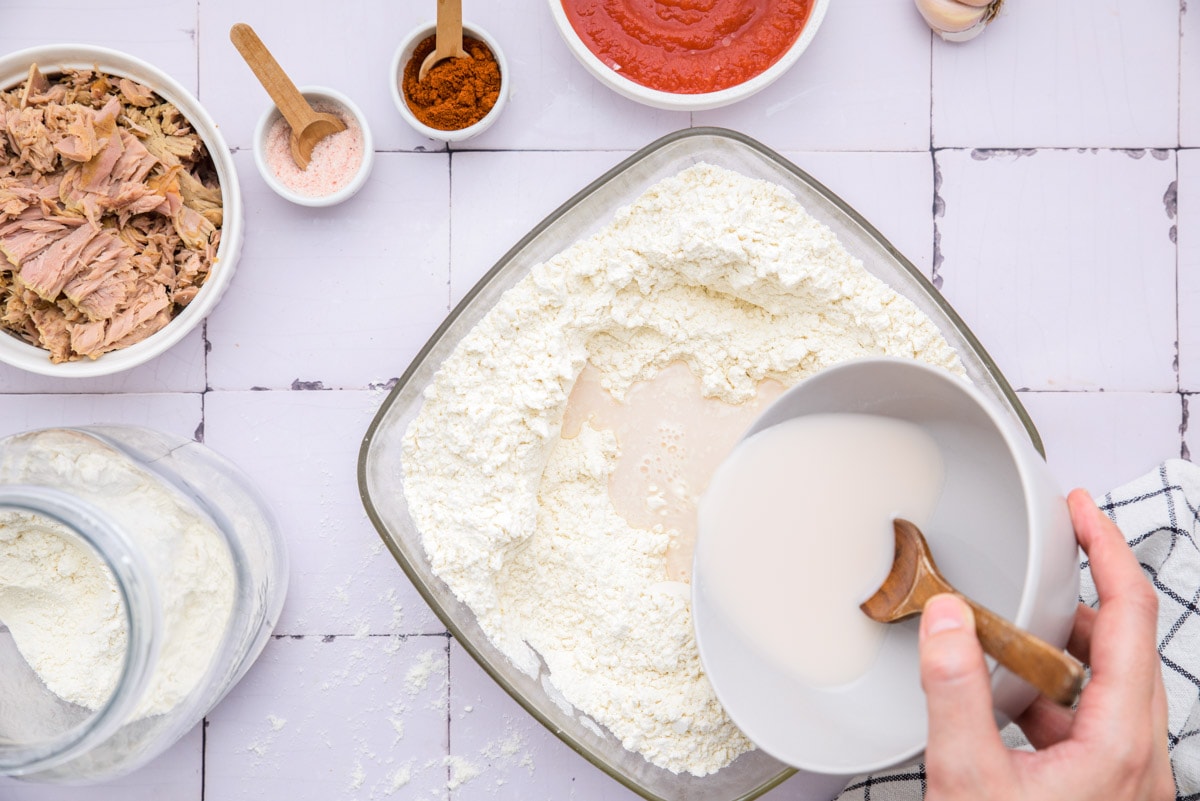
Pour the dissolved yeast into the large bowl.
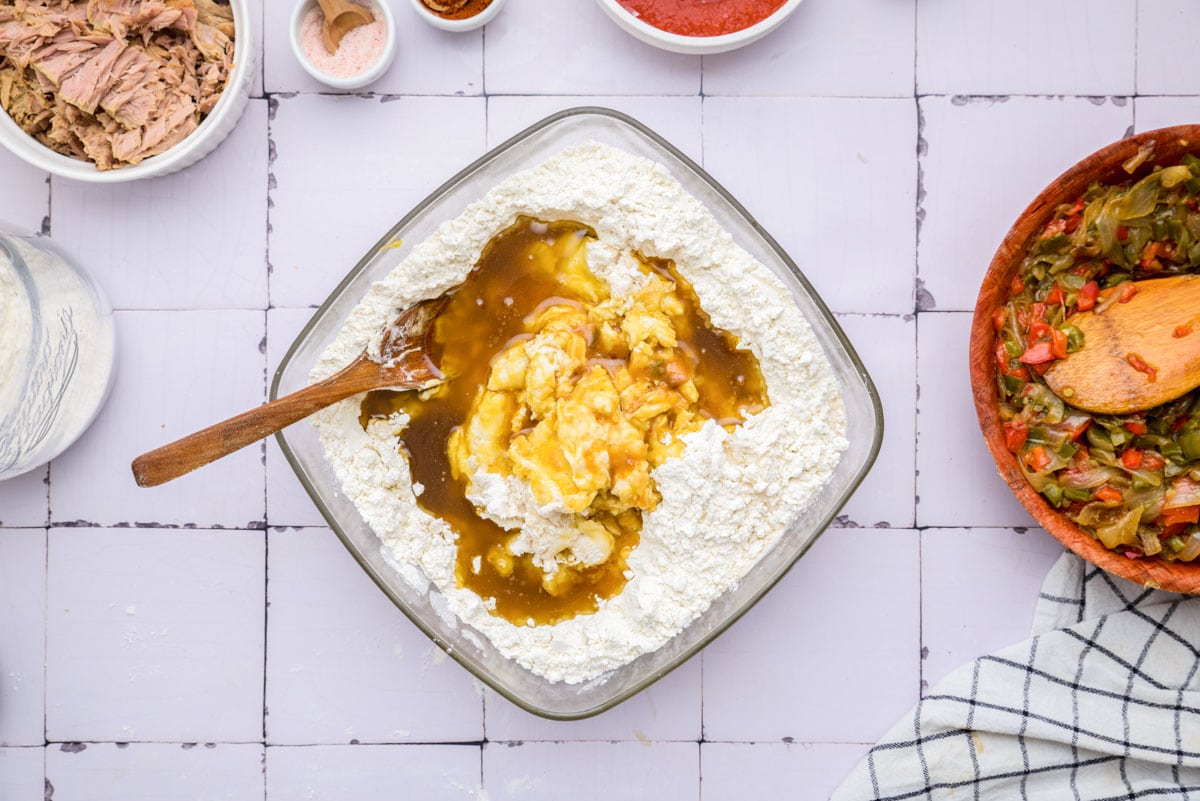
Add the drained oil from the veggies to the mixture. If you don’t have 5 fl oz of oil from the vegetables, add more raw olive oil until you have 5 fl oz (about 2/3 cup).
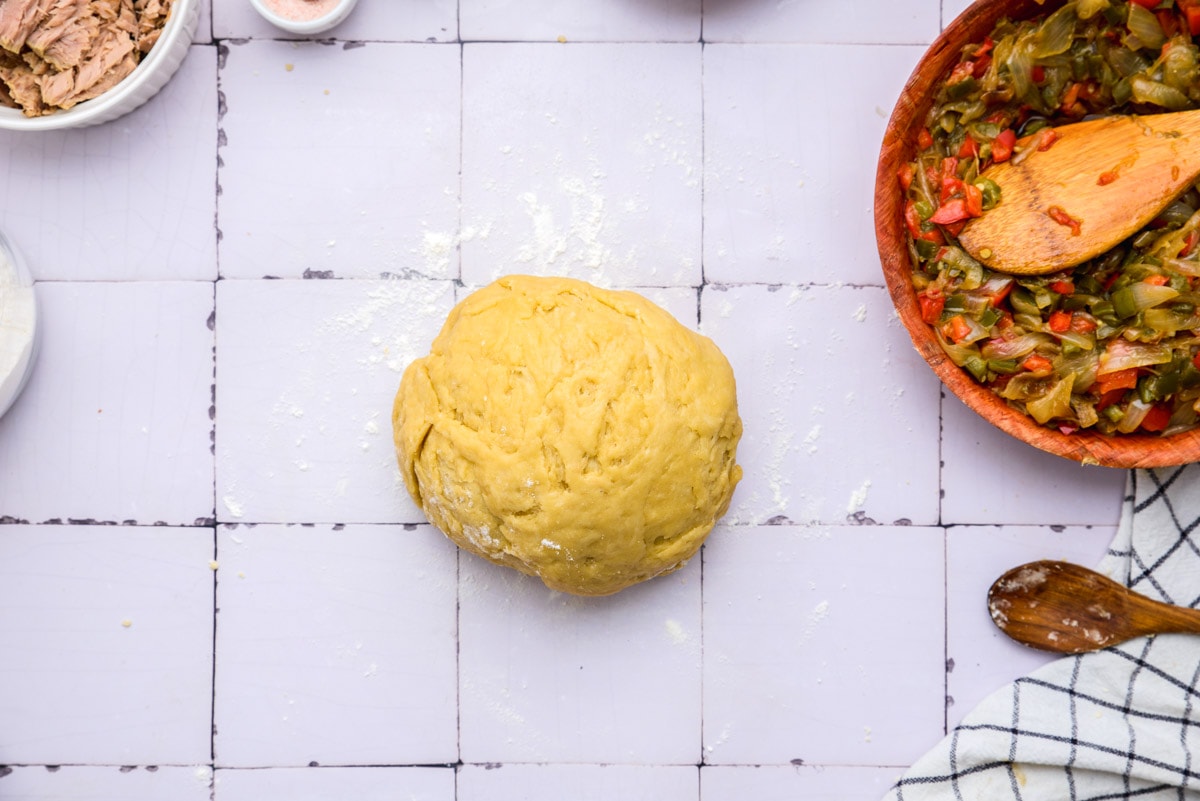
Mix and knead the dough until you have a soft ball (about 15 minutes).
Brush with a little oil and let rest in the covered bowl at room temperature until doubled in size.
The rising time will depend on the temperature of your kitchen – it may take longer to rise if your kitchen is cold, so be sure to place the dough near a heat source and cover it with kitchen towels.
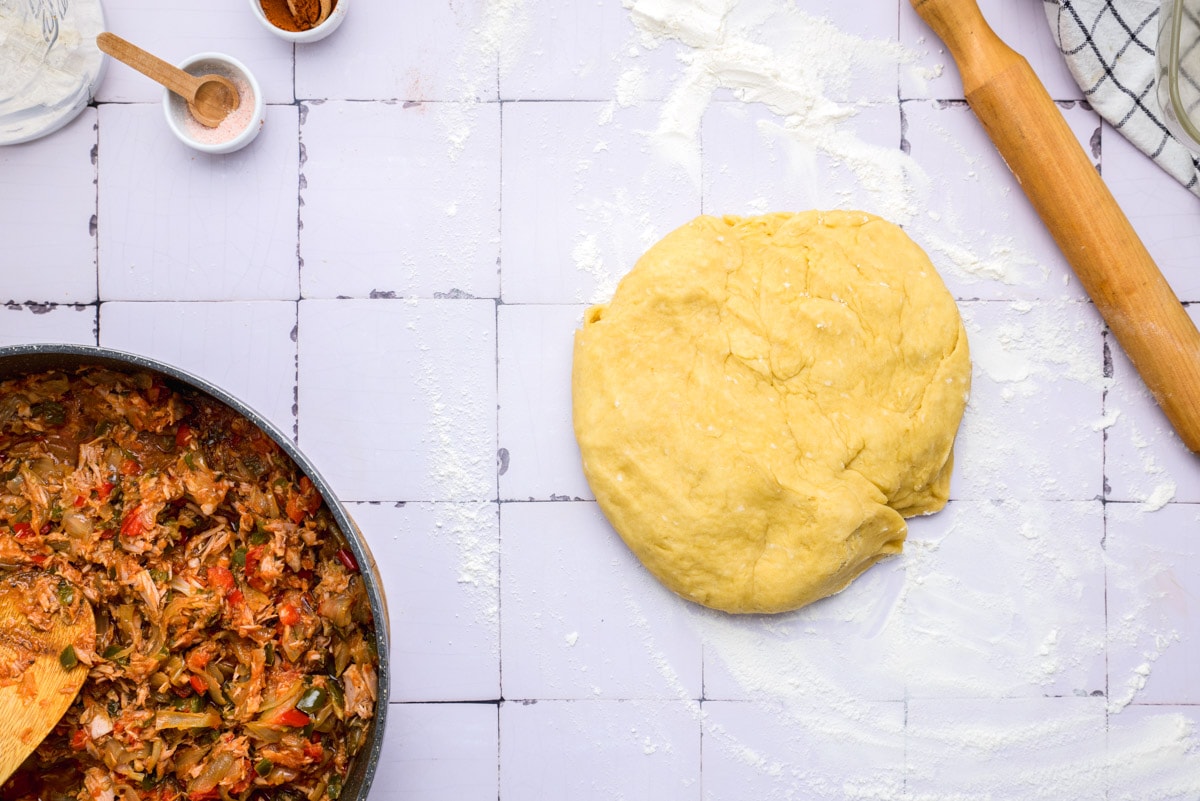
Once the dough has doubled in size, sprinkle a little flour on the work surface and gently knead the dough for another 10 minutes.
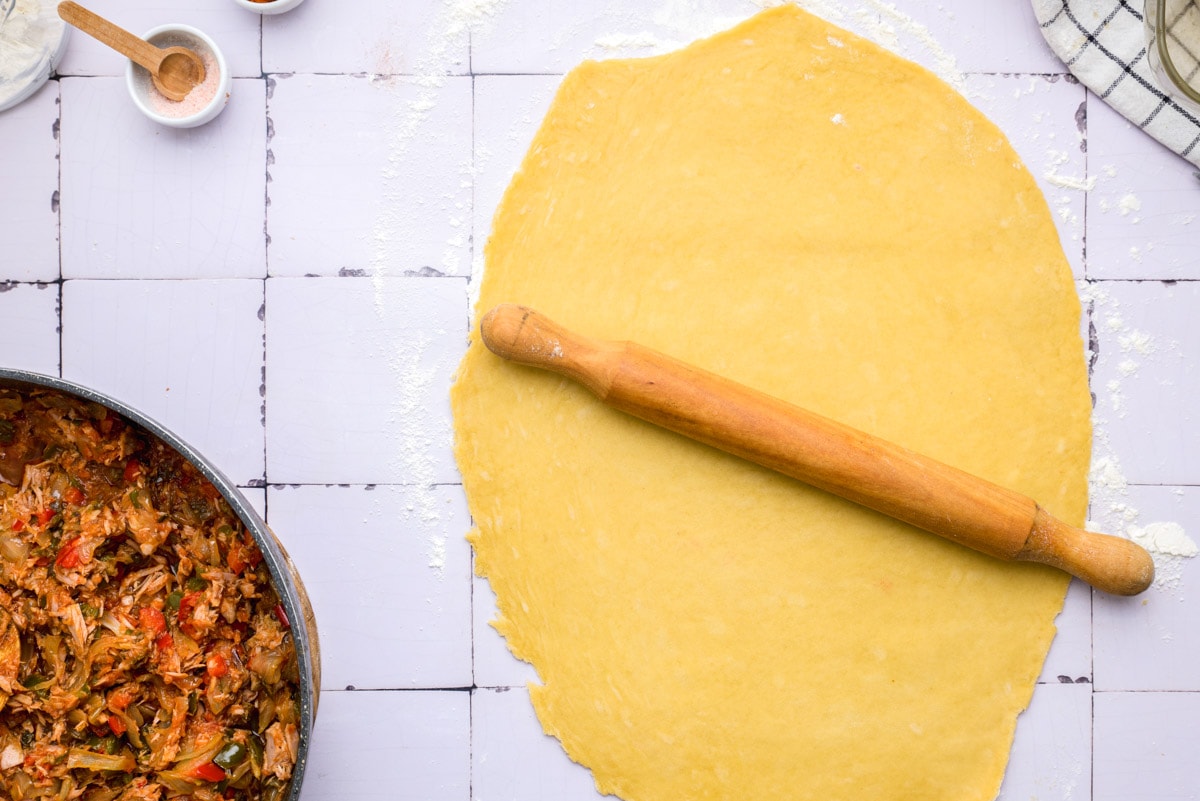
Divide the dough in half and roll out both pieces of dough into a thin layer (the thinner the better).
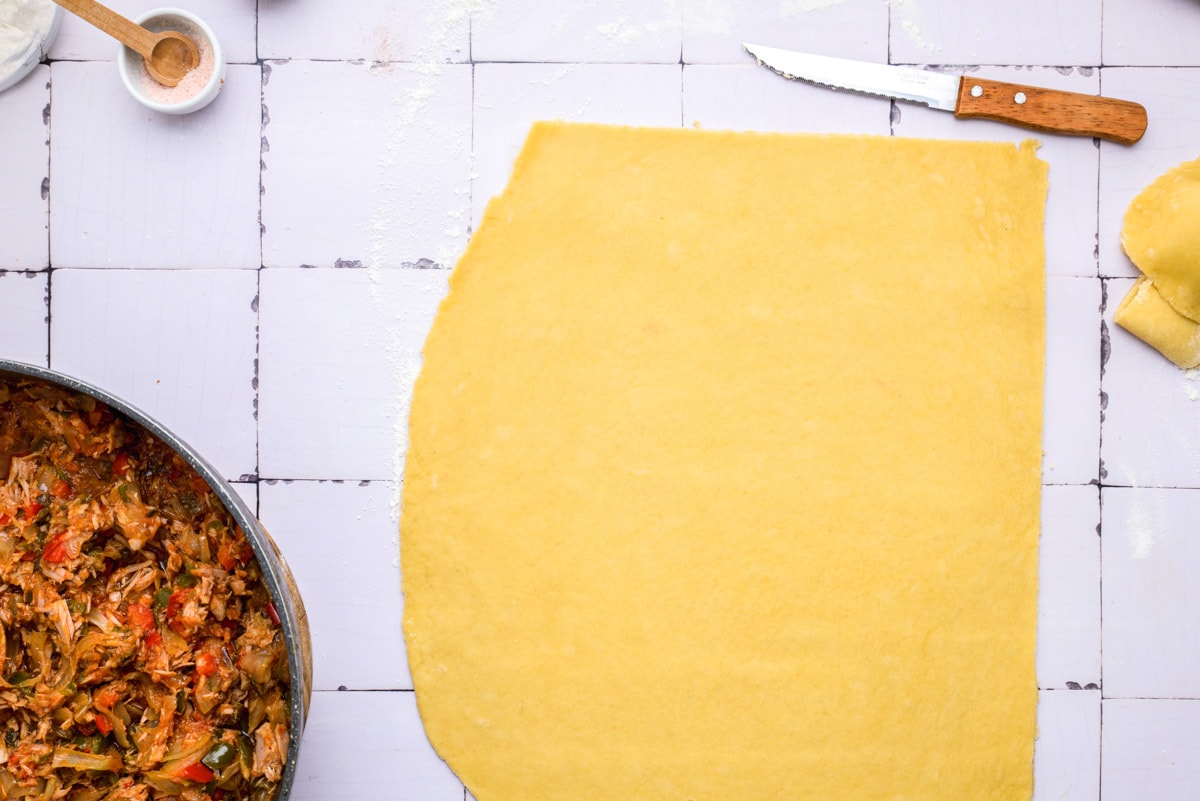
Cut the sides with a knife to form a rectangle. Save the cuttings for garnish.
At this time, preheat the oven to 400 degrees Fahrenheit.
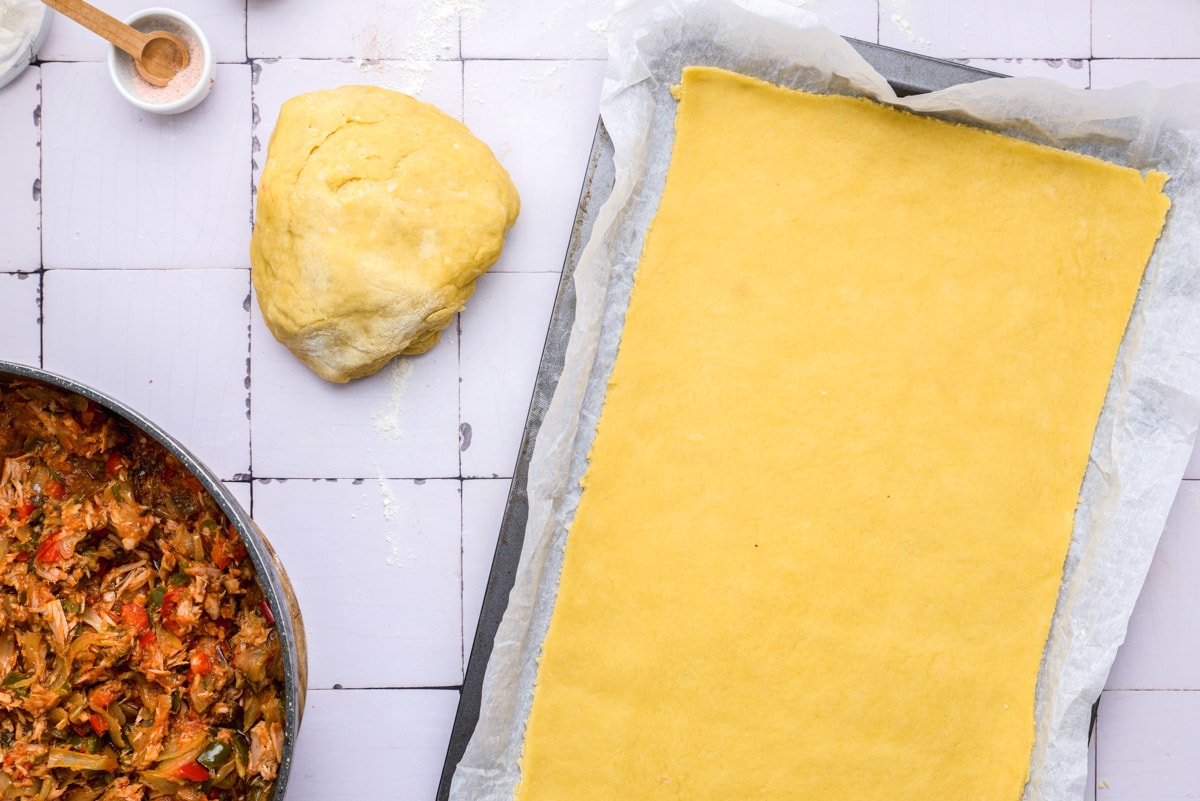
Line a baking sheet with parchment paper and place one layer of dough on it to serve as the base of the empanada.
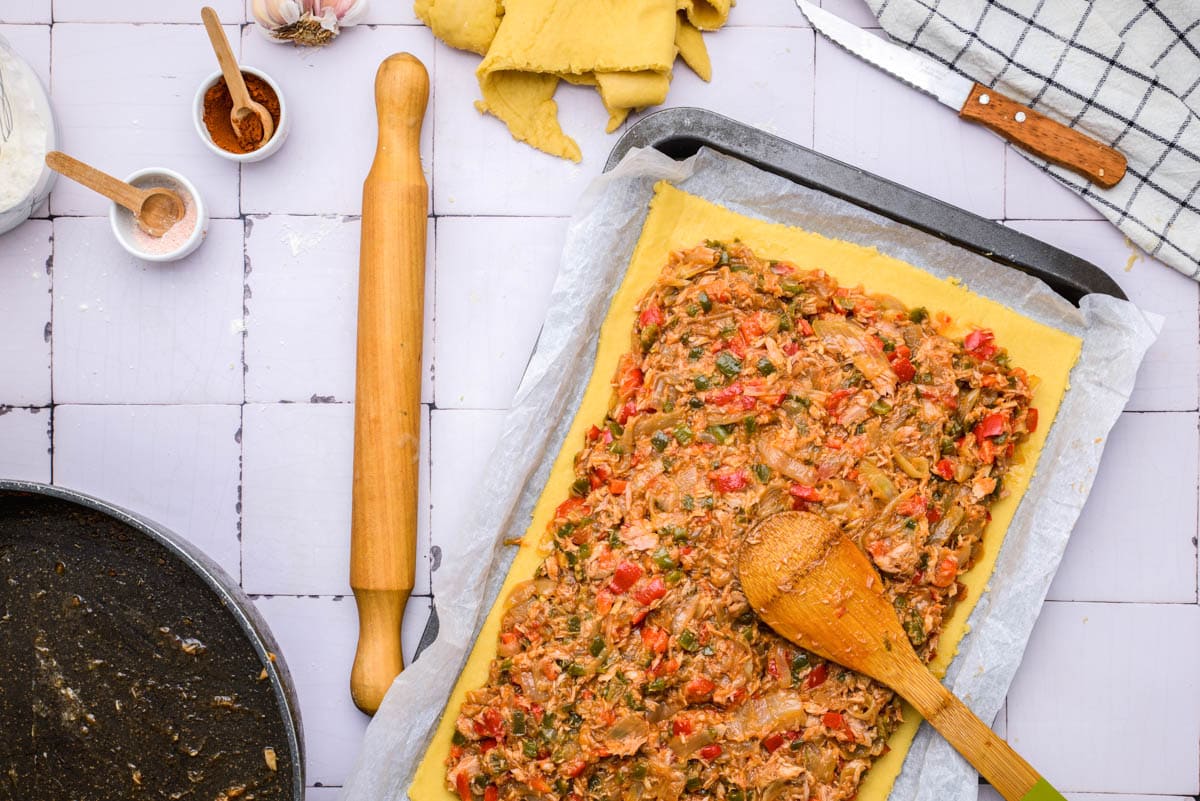
Spread the filling evenly on top of the base layer, leaving enough room on all sides to seal (about 3/4 inch).
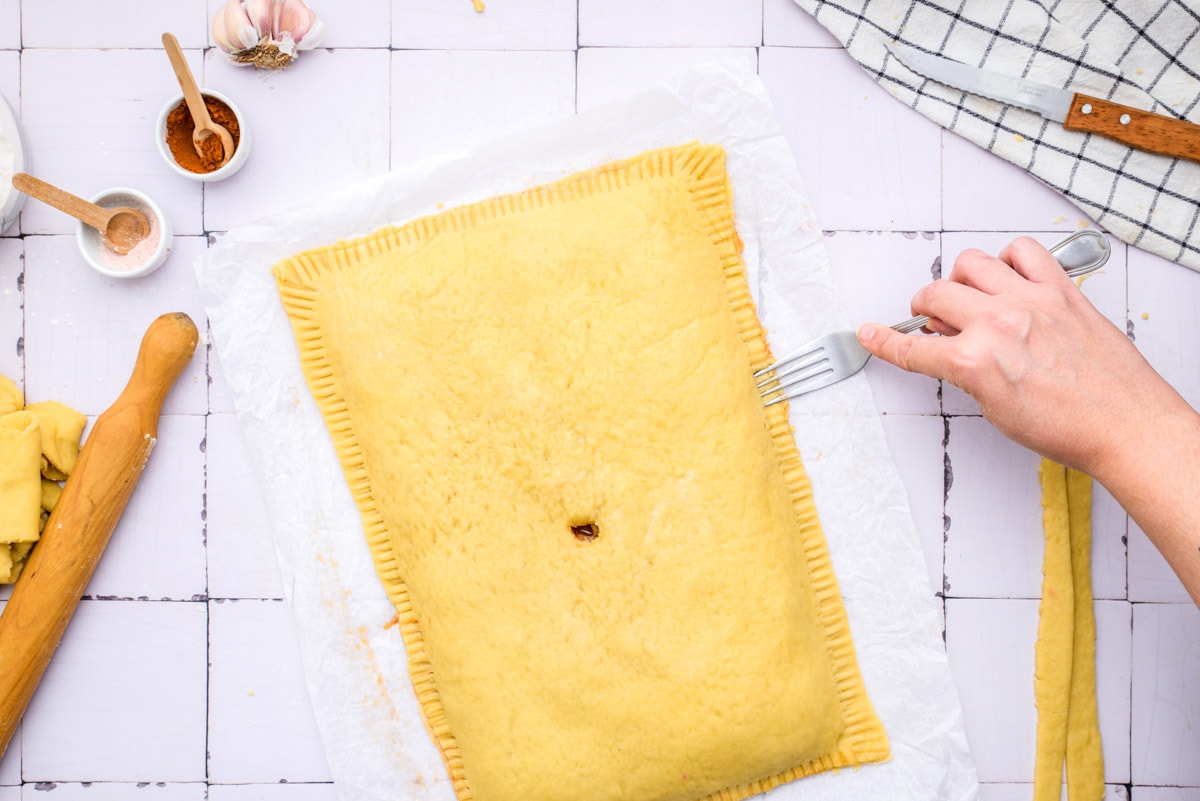
Place the top layer on top and seal. You can do this by pressing with a fork or by pinching both layers with your fingers. I like to do a combination of both, first fork and then pinching.
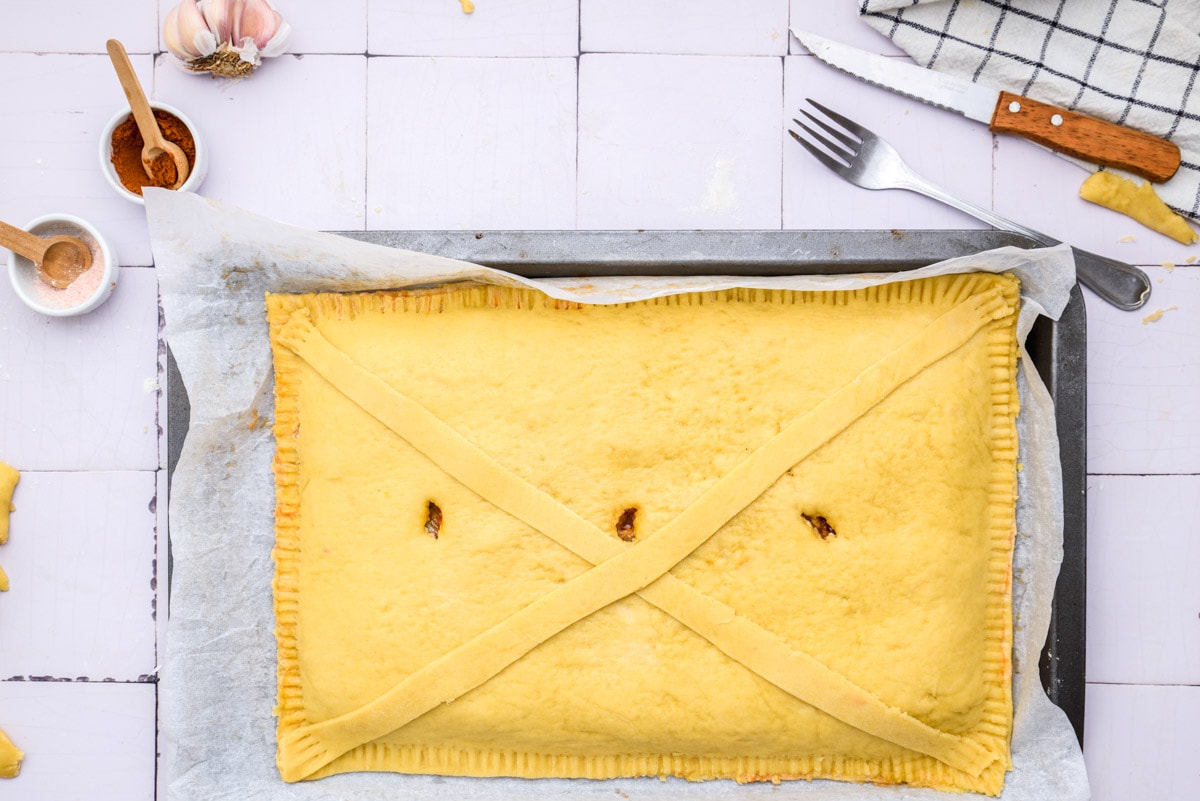
Cut 2 or 3 small holes in the center of the top to allow steam to escape. I like to make 3 holes and also some tiny ones with the tip of a knife all over the empanada.
Roll out the rest of the dough and make a few ornaments as you like.
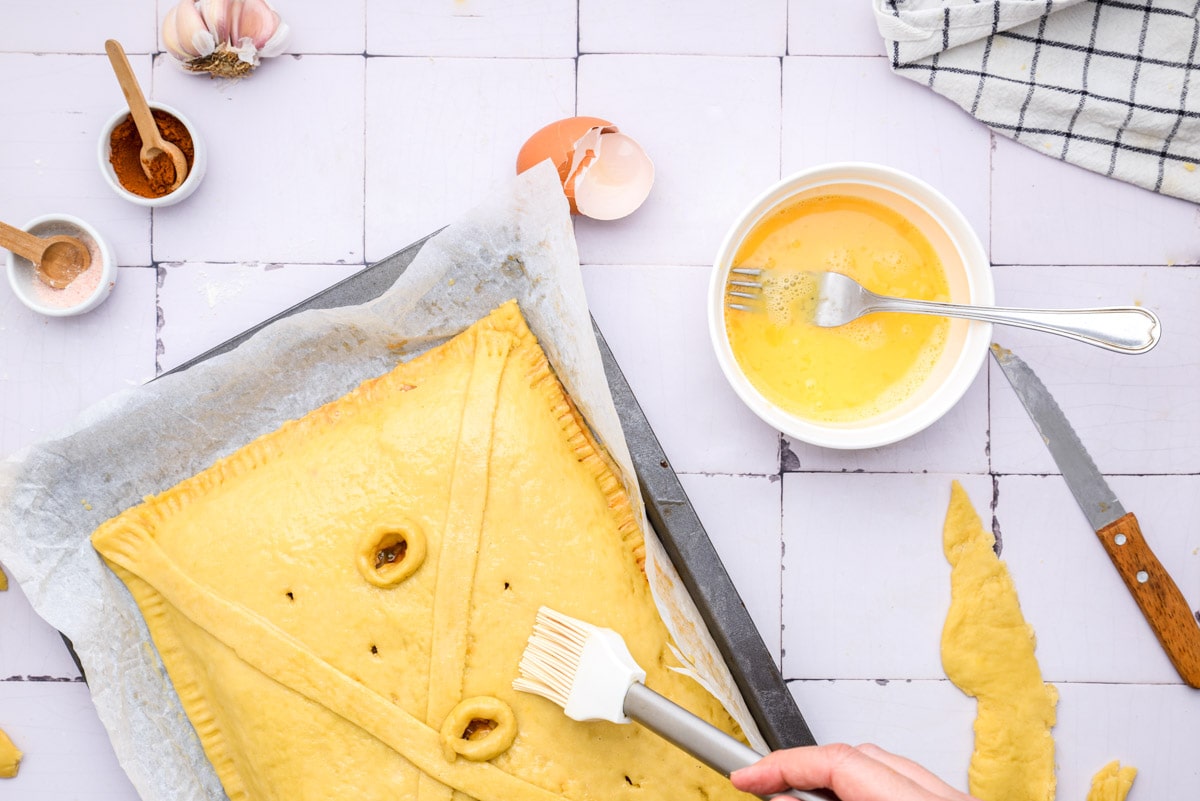
Crack the egg, beat it, and brush the top of the empanada with the egg.
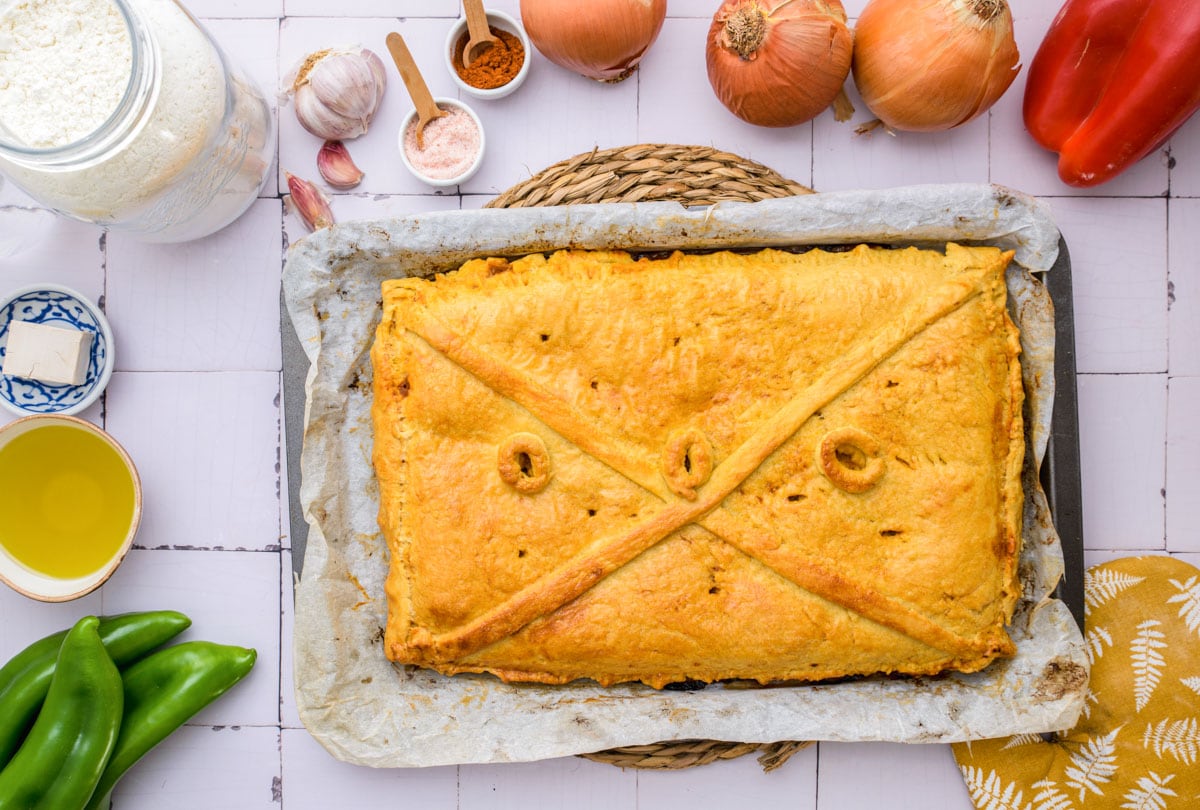
Reduce the temperature of the oven to 355 degrees Fahrenheit, add the empanada, and bake it for 35 minutes until golden brown.
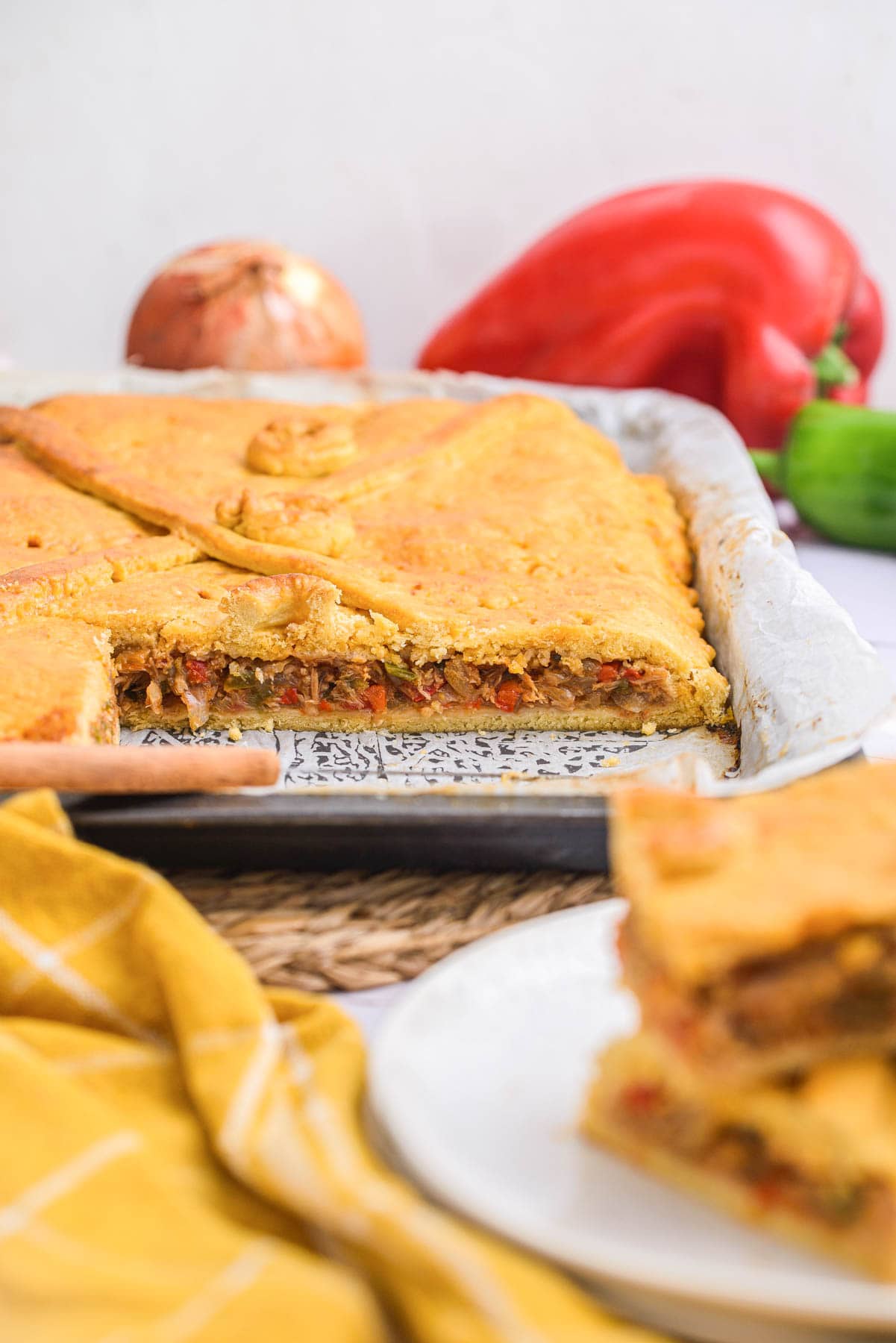
Serve the empanada hot. If it’s served for lunch or dinner, it’s often accompanied by a glass of white wine (Galicia is known for its very nice white wines, such as Albariño) or cold beer.
It is usually the first course or appetizer of an abundant meal. Enjoy!
Storage Tips
If you have leftovers, store them in a sealed container in the fridge for up to 4 days.
After being in the fridge the dough can lose its crunch. To make it crispy again, heat it in a pan with a bit of olive oil and cook for 1 minute on each side.
Alternatively, heat it in the air fryer at 395 degrees Fahrenheit for a couple of minutes.
FAQ
Empanada gallega is a traditional savory pie from the Spanish region of Galicia. The classic filling is tuna, peppers, and onions, but there are other variations of the recipe. It can be found in bakeries, bars, and restaurants and is typically eaten hot at different times of the day.
Since Empanada Gallega is specific to the region of Galicia, it is traditionally eaten there. Many towns in Galicia have their own variation of the recipe.
Related Recipes
For more tasty Spanish recipes, here are some other flavorful recipes that you can make at home!
- Spanish Omelette
- Ensalada Mixta
- Vegetable Paella (Paella de Verduras)
- Fried Calamari (Spanish Calamares a la Romana)
- Pan Con Tomate (Spanish Tomato Bread)
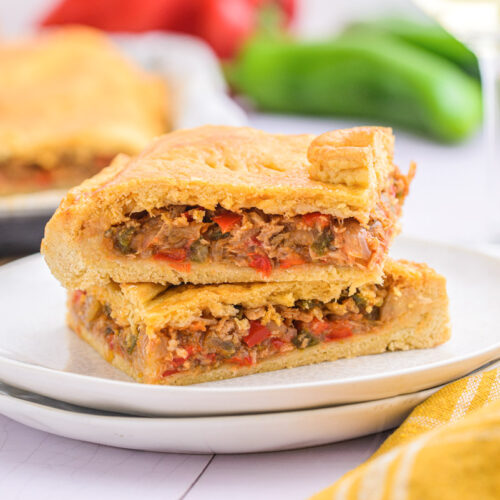
Empanada Gallega
Ingredients
The Filling
- 3 yellow onions
- 1 Italian green pepper, or green bell pepper
- 1 red bell pepper
- 3 garlic cloves
- 1 cup tomato sauce
- 13 ounces canned tuna, drained
- 1 tablespoon paprika
- 5 fluid ounces olive oil, extra virgin (about 2/3 cup)
- 1 1/2 teaspoons salt, or to taste
The Dough
- 4 1/2 cups all-purpose flour
- 1 ounce fresh yeast , (half the amount if using instant dry yeast)
- 3/4 cup water, warm
- 5 fluid ounces olive oil from the cooked filling
- extra olive oil, if needed
- 1 teaspoon salt
- 1 small egg
Instructions
Make The Filling
- Peel and thinly slice the onions. Cut the peppers in half and remove the core and seeds. Dice thinly. Peel and mice the garlic cloves.3 yellow onions, 1 Italian green pepper, 1 red bell pepper, 3 garlic cloves
- Heat the olive oil in a large pan. Once hot, add the veggies, salt, and paprika and cook over medium-low heat until they are golden, soft, and fragrant. The longer the better. Stir regularly.1 tablespoon paprika, 1 1/2 teaspoons salt, 5 fluid ounces olive oil
- Drain the oil using a fine mesh strainer and a bowl. Set the oil aside.
- Add the tuna and the tomato sauce to the filling and mix well. Set aside.1 cup tomato sauce, 13 ounces canned tuna
Make The Dough
- In a large bowl, combine the flour and salt and mix well.4 1/2 cups all-purpose flour, 1 teaspoon salt
- In a small bowl, dissolve the fresh yeast in warm (not boiling) water. If you're using instant dry yeast, you don't need to dissolve it first (just add it to the large bowl along with the water). Add the yeast and water to the large bowl and stir.1 ounce fresh yeast, 3/4 cup water
- Add the drained oil from the veggies to the mixture. If you don’t have 5 fl oz of oil from the vegetables, add more raw olive oil until you have 5 fl oz (about 2/3 cup).5 fluid ounces olive oil from the cooked filling, extra olive oil
- Mix and knead the dough until you have a soft ball (about 15 minutes). Brush with a bit of oil and let it rise in a covered bowl at room temperature until doubled in size. The rising time depends on your kitchen temperature.
Assemble
- Once the dough has doubled in size, remove it from the bowl. Sprinkle a bit of flour on the work surface and knead the dough for another 10 minutes.
- Divide the dough in half and roll out both pieces of dough to a thin layer (the thinner the better). Cut the sides with a knife to form a rectangle. Save the cuttings for the garnish.
- Preheat the oven to 400 degrees Fahrenheit.
- Line a baking sheet with parchment paper and place a layer of the dough to serve as the base of the empanada.
- Spread the filling evenly on top of the base layer, leaving enough room on all sides to seal (about 3/4 inch).
- Place the top layer of dough on top and close. You can do this by pressing down with a fork or pinching both layers together with your fingers.
- Cut 2 or 3 small holes in the center of the top to allow steam to escape. Roll out the rest of the dough, make some ornaments and place them on top of the empanada.
- Crack and whisk the egg, then brush it on top of the empanada.1 small egg
- Reduce the temperature of the oven to 355 degrees Fahrenheit, place the empanada in the oven and bake for 35 minutes until golden brown.
Notes
- Use a good quality extra-virgin olive oil if possible.
- Use yeast that hasn’t expired. You can use instant dry yeast if you can’t find fresh yeast. Don’t use active dry yeast since it would have to be activated first.
- It’s better to make the filling first since you need the flavored oil for the dough. If you are in a rush, you can skip this and simply use raw olive oil for the dough. Alternatively, prepare the filling the day before and make the dough and empanada the next day.
- In the beginning, the dough may feel a bit hard and flaky, but keep kneading. Eventually, you’ll be able to form a ball, and once it has rested and risen, it will be much softer to knead.
- The rising time will depend on your kitchen temperature.
- Be sure to cut some holes into the empanada so that the steam can escape.
Nutrition
This nutritional information has been estimated by an online nutrition calculator. It should only be seen as a rough calculation and not a replacement for professional dietary advice.
